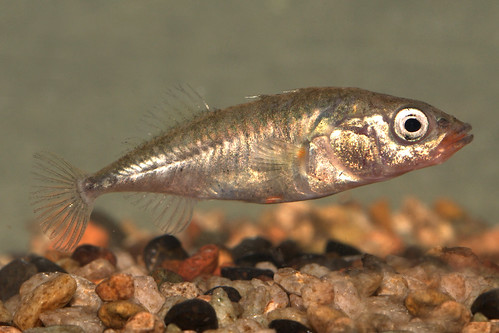By Elizabeth Pennisi, Science Now, April 4, 2012
 |
| Gasterosteus aculeatus |
A tiny fish is helping to answer a big question about
evolution. The threespine stickleback (Gasterosteus aculeatus) has long been
abundant in the sea. But after glaciers melted 10,000 years ago, many wound up
in new freshwater lakes and streams. In these unfamiliar environments, the fish
lost their bony plates and spines and developed novel behaviors and physiology.
A new study reveals that many of these relatively rapid changes were due not to
mutations in specific genes, as some biologists had long assumed, but rather to
changes in the activity of these genes. The finding should help focus more
attention on the role of gene regulation in evolution, not just of fish but of
all organisms, including humans.
For decades, evolutionary biologists have been
fascinated by the repeated evolution of freshwater traits in marine
sticklebacks. In these fish, evolution has duplicated itself thousands of times
as marine ancestors moved into fresh water in many parts of the Northern
Hemisphere, including Alaska, California, Europe, and Japan. All of these fish
have undergone similar changes in their kidneys, body shape, eye size, and
number of bony plates on their bodies. David Kingsley, an evolutionary
biologist at Stanford University in Palo Alto, California, took advantage of
this parallel evolution to look at how the genome causes these changes.
He, Kerstin Lindblad-Toh of the Broad Institute in
Cambridge, Massachusetts, and their colleagues first sequenced the DNA of a
stickleback from a lake in Alaska to a high degree of accuracy. With this
reference sequence as a guide, the researchers were able to, with less work,
sequence the genomes of 10 additional pairs of sticklebacks from around the
world. Each pair consisted of a marine individual and its nearby freshwater
relative.
Typically, any gene should be most similar among fish
from the same location. But if there was repeated evolution at a particular
region of the genome, that region should be alike in all the freshwater fish,
irrespective of how close they lived to each other. Kingsley's team scanned all
the genomes for regions where repeated evolution had occurred, finding 147 of
them and confirming that repeated evolution was rampant in these fish.
Next, the researchers counted how many of these regions
contained a gene. Then they compared the sequences of that gene among the
different fish. If the genes were the same in all the freshwater fish but
different from a marine counterpart, the researchers assumed that the gene
itself was responsible for the adaptation to fresh water. That happened in only
17% of the regions, Kingsley and his colleagues report online today in Nature.
Meanwhile, about 41% of the regions contained no gene, indicating that changes responsible for the
adaptation were regulating the activity of genes elsewhere in the genome. Another 43% contained a gene and
regulatory DNA, but because only the regulatory DNA was the same among the
freshwater fish, the researchers assumed that regulatory changes were at the
heart of those adaptations as well.
Researchers have documented repeated evolution in other organisms, but the sticklebacks are unique
because the freshwater transition has occurred so many times.
"Sticklebacks have been a phenomenal system for understanding rapid
evolution," says evolutionary biologist Erica Bree Rosenblum of the
University of California, Berkeley, who wasn't involved in the study.
"This paper shows that repeated evolution can occur by 'reusing' the same
genetic mechanisms over and over again."
For now, Kingsley has a genome-wide accounting of the reused
genetic changes involved in the transition to freshwater but doesn't know most
of the traits those changes control. He and other researchers are now trying to
track those down. "That will be the big next step," says Hopi
Hoekstra, an evolutionary biologist at Harvard University, who was not involved
in the study.
No comments:
Post a Comment